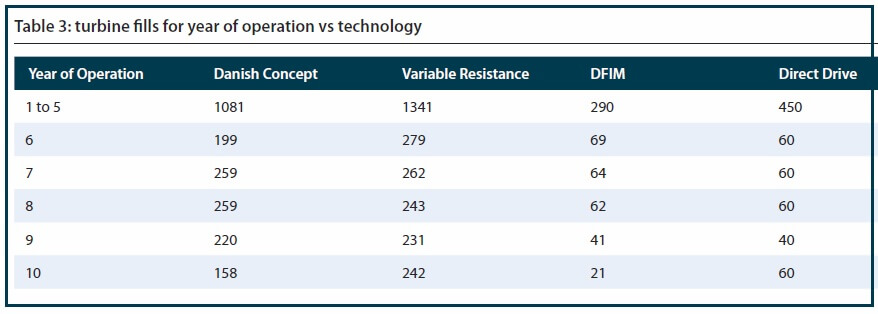Wind Energy Benchmarking Services / Wind Energy update
This 16-page paper examines the relationship between turbine type and reliability. Reliability data from Wind Energy Benchmarking Services is used to analyze turbines, grouped by technology and nameplate capacity, to identify the mean time to failure and mean repair time per failure. The analysis shows that turbines which use doubly fed induction machine technology encounter failures more often and experience longer repair times per failure, in comparison with other turbine technologies. The results also suggest no one single trend can be attributed to onshore turbines as a whole as reliability varies by technology and generation capacity. The paper concludes that the adoption of industry-wide benchmarking platforms such as that seen for gas turbines and Oil & Gas facilities is a key enabler for a better understanding of turbine reliability.
Introduction: The post warranty wind O&M landscape
The O&M landscape has gone through considerable changes in recent years. Owner Operators and IPP’s are increasingly examining a range of O&M options as their assets reach the end of warranty. A recent report by GCube noted that around 1/3 of all wind turbines are now reaching the end of O&M service agreements.
Operators, asset managers and those responsible for overall project operations are now assessing the value of independent service providers (ISP’s) maintenance contracts. Cost is often cited as an important issue in selecting an ISP vs the OEM end-of-warranty package option. At a time of decreasing subsidies and record low auction prices cost is increasingly significant, a trend expected to continue over the next 3 to 5 years. Navigant Research has noted that warranties have now expired on over 50% of the global installed turbine capacity.
Make Consulting predict that the global O&M market is set to grow from $9.7 billion in 2015 to $19.3 billion by 2021. This trend is particularly prevalent in the USA. IHS Energy Research forecast U.S. O&M spending will almost double to $6 billion by 2025 as a direct result of the number of turbines coming out of warranty.
This space has been further complicated by some of the M&A activity in recent years. For example, Vestas $60 million acquisition of Upwind in 2015 has already enabled it to win wind service contracts for 1.75 GW of GE Turbines for Berkshire Hathaway. This is of particular significance given the purchasing power of Berkshire Hathaway and shows that even those with the deepest pockets are assessing cost as a major factor in wind farm O&M.
Vestas has made further inroads into this sector with the €88 million acquisition of German turbine servicing firm Availon in early 2016.
Gamesa’s €2.6 million acquisition of B9 Energy in 2015 has now enabled it to bid on rival turbines in the UK and Ireland.
Utilities have been doing this for years. For example, Duke Energy acquired Outland Energy Services in 2005 to service its existing fleet and win in excess of 300 MW of tenders for non-owned assets. In 2016 Duke Energy joined forces with Siemens to combine service divisions.
Many familiar names in wind equipment manufacturing are trying to capture pieces of the O&M market. Among them are Enercon, Gamesa, GE Wind, Goldwind, Nordex, Siemens, Suzlon Group, United Power and Vestas.10
For the rest of the report: https://goo.gl/RRcZqq
Filed Under: News, Turbines





